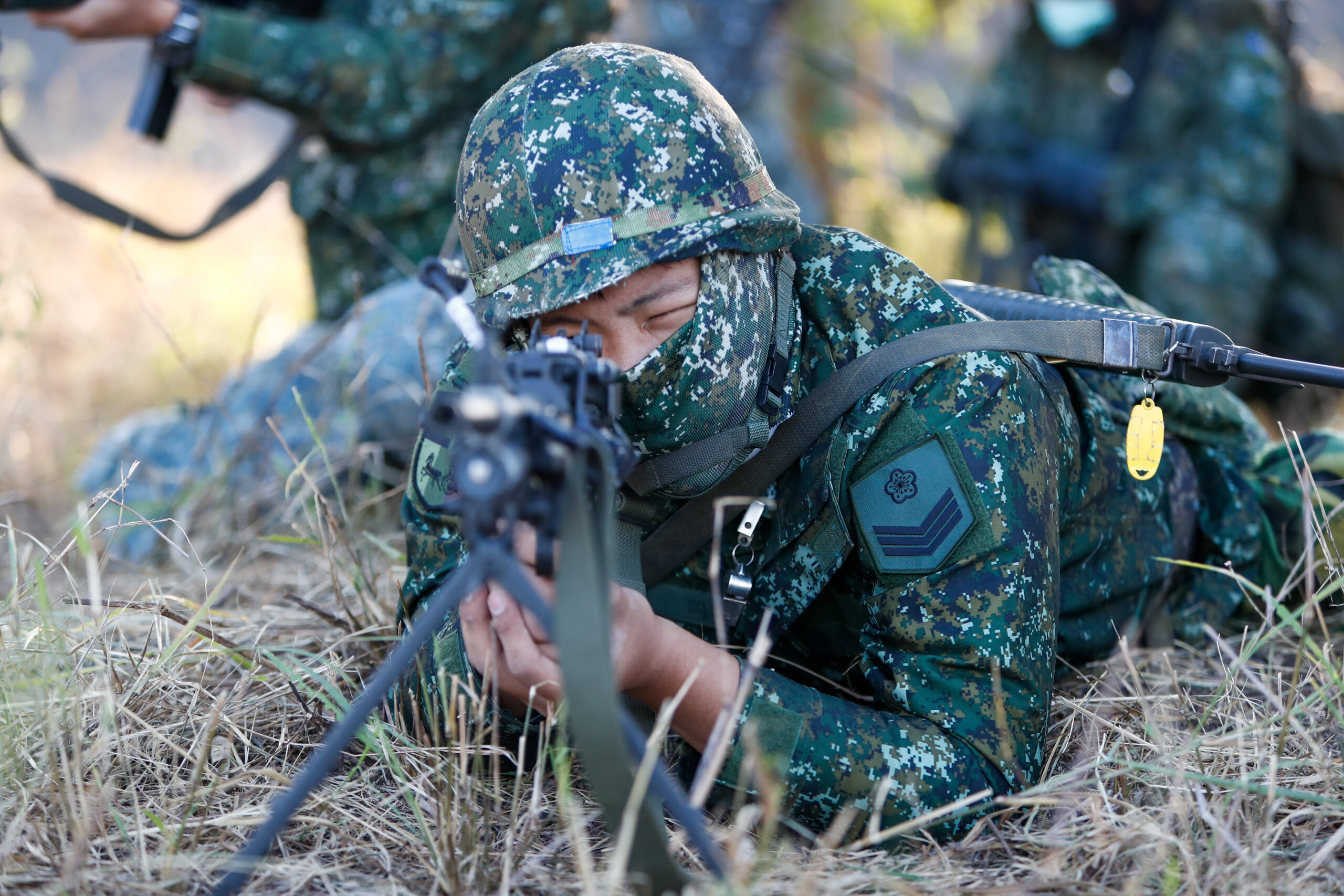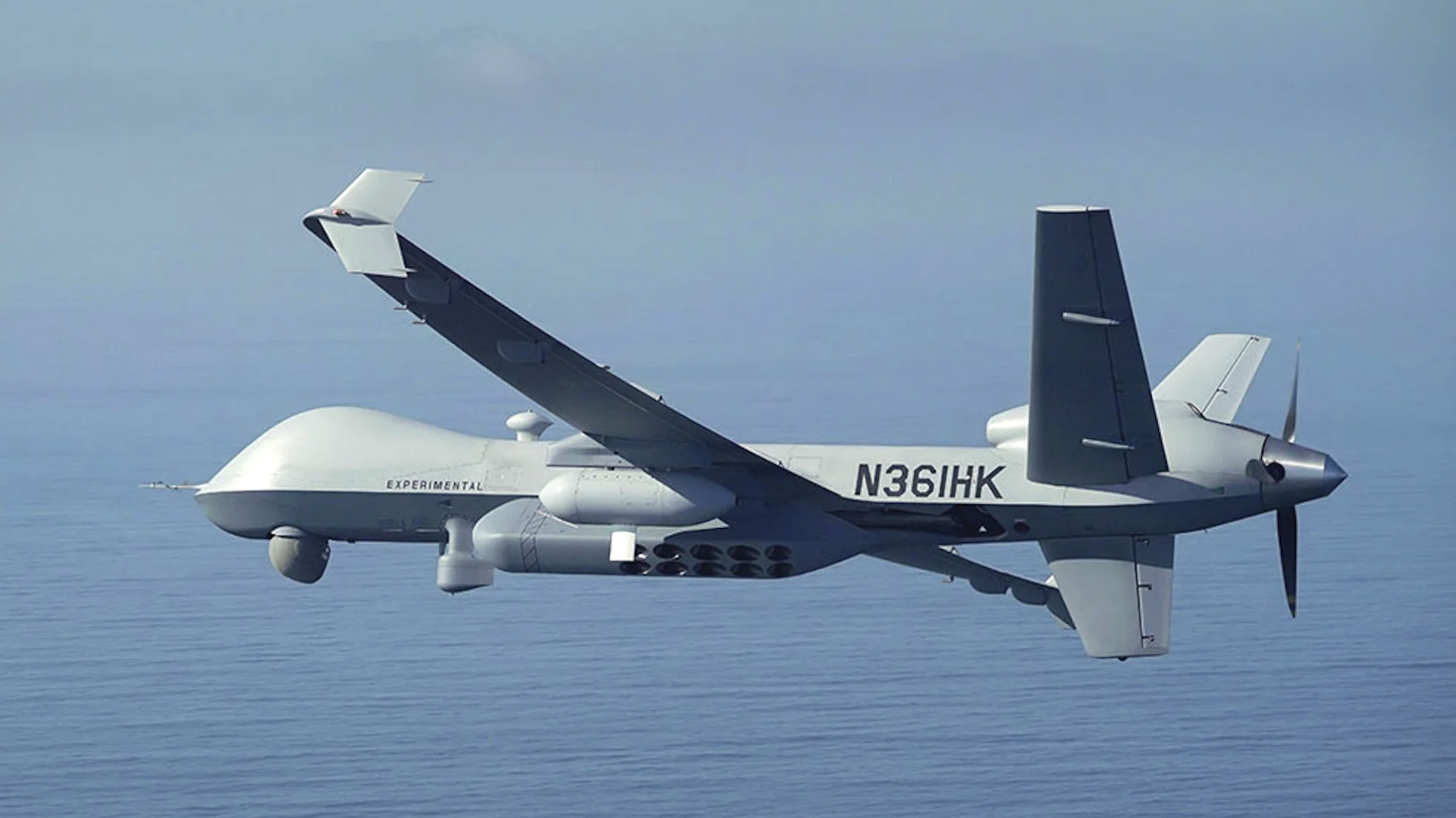Taiwan’s defense ministry has denied that it’s currently part of tripartite plans to share intelligence gathered by naval surveillance drones with the United States and Japan. In an unusual step, Taiwan’s Ministry of National Defense (MND) moved to rebuff the contents of an article that suggested that, in particular, its forthcoming MQ-9B Sea Guardian drones would be used in this way. But whatever platforms were being used, this kind of intelligence-sharing has implications in peacetime, and especially were China to launch an offensive against the island.

In a tweet today, the Republic of China (ROC) Ministry of National Defense said: “The MND has not yet been informed of plans to share real-time data from naval reconnaissance drones with the U.S. and Japan as has been reported by some media outlets.” The MND then added: “We would like to kindly request that due diligence be exercised in verifying the source of information to prevent misleading the public.”
The report referenced by the MND appeared today in the British Financial Times newspaper.
The article — said to be based on “four people familiar with the project” — states that the four MQ-9Bs ordered by Taiwan will be equipped so that they can be “integrated into the same system that U.S. forces in the region and the Japanese Self-Defense Force will use.”
“We will be taking a practical approach towards ensuring that integration is done as quickly as possible,” the FT reported one of those people saying, after they had been briefed on the project.
Such an arrangement would allow the United States, Japan, and Taiwan to share a common operational picture, with the implication being that surveillance and early warning of Chinese military operations in and around Taiwan would be significantly enhanced. Taiwan’s close proximity paired with a drone like Sea Guardian would provide persistent aerial surveillance of Chinese activities in the region.

Were this to happen, it would not only bring a boost to the intelligence, surveillance, and reconnaissance (ISR) capabilities of all three countries, but it would also suggest that the United States is increasingly willing to coordinate with the ROC Armed Forces, including in the event of an invasion or other military campaign launched by Beijing.
General Atomics is scheduled to deliver four MQ-9B Sky Guardians to Taiwan beginning in 2025. A $218-million contract for the maritime variant of the Reaper drone was confirmed last month. It includes four MQ-9B unmanned aerial vehicles, two control stations, spare parts, and support equipment.

Taiwanese interest in the MQ-9B dates back further, with a potential U.S. government Foreign Military Sales (FMS) announced in November 2020. The package outlined included an ISR payload consisting of the L3 Wescam MX-20 multi-spectral targeting system, Raytheon SeaVue maritime multirole radar, and Leonardo Sage 750 electronic surveillance measures system. Also included were satellite communications stations, allowing intelligence to be transmitted at beyond-line-of-sight.
While weapons were not specified, the Sky Guardian is able to carry offensive armament, which would allow them to target PLA ships and other assets, including submarines, as you can read about here. Even without armament, these drones are a powerful surveillance asset that would be able to detect and track PLA warships, or other elements of an invasion force, and also to target them on behalf of other platforms.
With its medium-altitude and long-endurance performance, the MQ-9B is well suited to monitoring the Taiwan Strait, or other maritime areas around Taiwan, with the Chinese threat increasingly being projected from multiple directions. The drones will also be able to roam further afield, providing critical, real-time intelligence on the movement of PLA warships in the First Island Chain, which extends from Japan to the Philippines.

It’s notable, of course, that the statement today from the ROC Ministry of National Defense doesn’t prevent it from joining a future intelligence-sharing plan, whether that includes data from the new MQ-9Bs, or otherwise. Stating that the MND “has not yet been informed of plans” clearly leaves the door open to this.
Whatever the truth behind the report in the FT, it’s obvious that a disclosure of this kind, providing it’s true, could be uncomfortable for the players involved.
The question of what degree Taiwan is involved in intelligence sharing and broader military cooperation with the United States has long been contentious, especially in regard to relations between Washington and Beijing.
After all, since 1979, the United States has not formally been part of a mutual defense treaty with Taiwan, having instead switched diplomatic recognition to Beijing.
Any move toward enhancing the U.S. military relationship with Taiwan, or providing new weapons and support, is bound to invoke a hostile reaction from China. In particular, intelligence sharing is seen by Beijing as being especially problematic, since it’s seen as highly escalatory, effectively making the United States an active party in Taiwanese military operations directed against the mainland. It’s also an acknowledgment of the vital role that could be played by U.S. intelligence, above all, were it to be shared with Taiwan in a time of conflict or leading up to it.

Using now familiar language, Wang Wenbin, a spokesperson for the Chinese Foreign Ministry, called upon the United States and Japan to “stop creating military tensions and causing trouble for stability in the Taiwan Strait.” He added: “We firmly oppose military contact between Taiwan and countries that have established diplomatic ties with China.”
More broadly, any kind of U.S. involvement in issues relating to Taiwan is viewed by Beijing as dangerous meddling in the fate of the island, which it sees as part of its territory, and which it has not ruled out using force to bring back within its fold.
As for the future of Taiwanese MQ-9B operations, some kind of cooperation, or at least synergies with the United States and potentially with other regional allies looks quite likely.
After all, in other theaters — notably in Europe, Africa, and the Middle East — the Pentagon has made efforts to integrate operations, at least to a degree, to ensure interoperability and effectiveness. Referring to the Sea Guardian and Reaper in the wider Asia-Pacific region, Lt. Gen. Steven Rudder, the former commander of the U.S. Marine Corps in the Pacific, told the FT: “The MQ-9 is a relatively new system to this theater, and we have tried very hard to begin to develop an MQ-9 web of orbits with our partners out here.”

As well as the Sea Guardians heading to Taiwan, other MQ-9 variants are also becoming established in the Asia-Pacific region. The U.S. Marine Corps recently received its first extended-range MQ-9s that will operate from Hawaii, while the U.S. Air Force recently began deploying MQ-9s at Kanoya Air Base in Japan. Also in Japan, the local Coast Guard and Maritime Self-Defense Force are acquiring MQ-9 variants. Taken together, some kind of streamlining between these different units would appear to be inevitable, although it may not necessarily extend to a common operational picture.
Nevertheless, as long as the People’s Liberation Army (PLA) continues to flex its muscles in the Taiwan Strait, and around the island more generally, including drills that are dress rehearsals for encirclement or invasion, then the kind of intelligence that can be gathered by the MQ-9 and other surveillance assets in the region will be of great value for Taiwan, the United States, and Japan.
In the latest demonstration of PLA military might in the Strait, today Taiwan’s Ministry of National Defense reported that 37 Chinese military aircraft flew into the island’s air defense identification zone, or ADIZ, some of which then flew into the western Pacific. Among the aircraft involved were J-11 and J-16 fighters, H-6 bombers, YU-20 aerial refueling tankers, and surveillance aircraft.
It’s worth noting at this point that Taiwan’s ADIZ covers not only the entirety of the strait but also portions of mainland China, too.
Regardless, this kind of mass air activity by the PLA is becoming increasingly commonplace. The biggest such incursion took place in August last year, in response to the visit to Taiwan by U.S. Speaker of the House Nancy Pelosi, and saw 68 PLA aircraft and 13 warships underway in the strait — previously, the biggest number of aircraft to enter the strait in a single day was 56, recorded in October 2022.

Drones, too, many of them in a broadly similar class to the MQ-9B, are increasingly being used by China to surveil the Taiwan Strait as well as other strategic areas of interest near Japan. In many ways, these PLA drones are being used in a very similar way as Taiwan will employ its Sea Guardians. In one noteworthy mission last April, a Chinese TB-001 Scorpion medium-altitude, long-endurance (MALE) drone flew an apparently unprecedented mission around Taiwan, according to authorities on the island. This was the first time that the Ministry of National Defense publicly acknowledged that a PLA aircraft had ‘encircled’ the island in this way.

PLA aircraft and warships are making more regular shows of force into Taiwanese and Japanese areas of interest, as well as elsewhere in the strategically important East China and South China Seas. As long as that situation continues, the intelligence gathered by drones and other ISR platforms in these areas will be of great interest to Taiwan, the United States, Japan, as well as other regional allies. With that in mind, while Taiwan’s Ministry of National Defense may have moved to distance itself from any intelligence-sharing plan, enhanced cooperation between these three powers is only likely to increase in the future.
Contact the author: thomas@thedrive.com
